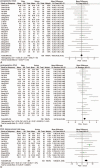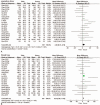Mini-plate fixation versus suture suspensory fixation in cervical laminoplasty: A meta-analysis
- PMID: 28151906
- PMCID: PMC5293469
- DOI: 10.1097/MD.0000000000006026
Mini-plate fixation versus suture suspensory fixation in cervical laminoplasty: A meta-analysis
Abstract
Background: Both the mini-plate fixation and suture suspensory fixation techniques are extensively applied in cervical laminoplasty, but which technique is superior has not been ascertained. The purpose of this meta-analysis is to compare the results between mini-plate fixation and suture suspensory fixation in cervical laminoplasty for the patients with multilevel cervical compressive myelopathy.
Methods: PubMed, Embase, the Cochrane library, CNKI, and WANFANG were searched for studies that compared mini-plate fixation and suture suspensory fixation in cervical laminoplasty up to November 1, 2016. We calculated odds ratio (OR) with 95% confidence interval (CI) for dichotomous outcomes and mean difference (MD) with 95% CI for continuous outcomes. Review Manager 5.3 was used for the statistical analyses.
Results: A total of 25 studies, involving 1603 participants, were included in this review. The results of this meta-analysis indicated that there were statistically significant differences in postoperative Japanese Orthopedic Association (JOA) scores (MD = 0.67, 95% CI: 0.34-0.99, P < 0.001), JOA scores improvement rate (MD = 4.00, 95% CI: 2.51-5.50, P < 0.001), postoperative Visual Analogue Score (VAS) (MD = -0.81, 95% CI: -1.36 to -0.26, P = 0.004), postoperative range of motion (ROM) (MD = 4.15, 95% CI: 2.06-6.23, P < 0.001), postoperative cervical lordosis (MD = 3.1, 95% CI: 2.02-4.18, P < 0.001), postoperative anteroposterior diameter of the spinal canal (MD = 1.53, 95% CI: 0.11-2.95, P = 0.03), postoperative open angle (MD = 1.93, 95% CI: 0.14-3.71, P = 0.03), postoperative cross-sectional area of the spinal canal (MD = 37.10, 95% CI: 26.92-47.29, P < 0.001), axial symptoms (OR = 0.28, 95% CI: 0.20-0.37, P < 0.001), operation time (MD = 4.46, 95% CI: 0.74-8.19, P = 0.02), and blood loss (MD = 9.24, 95% CI: 6.86-11.62, P < 0.001). However, there was no statistically significant difference in C5 palsy (OR = 0.82, 95% CI: 0.37-1.84, P = 0.63).
Conclusions: As compared with suture suspensory fixation, mini-plate fixation in cervical laminoplasty appears to achieve better clinical and radiographic outcomes with fewer surgical complications. However, mini-plate fixation is associated with bigger surgical trauma. This conclusion should be interpreted cautiously and more high-quality, randomized controlled trials are needed in the future.
Conflict of interest statement
The authors report no conflicts of interest.
Figures










Similar articles
-
Is Mini-Plate Fixation Superior to Suture Suspensory Fixation in Cervical Laminoplasty? A Meta-Analysis.World Neurosurg. 2016 Sep;93:144-53. doi: 10.1016/j.wneu.2016.06.011. Epub 2016 Jun 11. World Neurosurg. 2016. PMID: 27302561 Review.
-
Comparison of anchor screw fixation versus mini-plate fixation in unilateral expansive open-door laminoplasty for the treatment of multi-level cervical spondylotic myelopathy.Medicine (Baltimore). 2018 Dec;97(49):e13534. doi: 10.1097/MD.0000000000013534. Medicine (Baltimore). 2018. PMID: 30544458 Free PMC article.
-
Clinical and radiography results of mini-plate fixation compared to suture suspensory fixation in cervical laminoplasty: A five-year follow-up study.Clin Neurol Neurosurg. 2015 Nov;138:188-95. doi: 10.1016/j.clineuro.2015.09.004. Epub 2015 Sep 9. Clin Neurol Neurosurg. 2015. PMID: 26379265
-
Clinical and radiographic outcome of unilateral open-door laminoplasty with alternative levels centerpiece mini-plate fixation for cervical compressive myelopathy: a five-year follow-up study.Int Orthop. 2016 Jun;40(6):1267-74. doi: 10.1007/s00264-016-3194-3. Epub 2016 Apr 18. Int Orthop. 2016. PMID: 27087625
-
Mid- to long-term clinical outcomes of modified technique skip-level titanium plate fixation in cervical laminoplasty compared to continuous fixation.J Orthop Surg Res. 2025 Jan 27;20(1):100. doi: 10.1186/s13018-025-05491-y. J Orthop Surg Res. 2025. PMID: 39865339 Free PMC article.
Cited by
-
Quality assessment of systematic reviews of surgical treatment of cervical spine degenerative diseases: an overview.Einstein (Sao Paulo). 2022 Apr 20;20:eAO6567. doi: 10.31744/einstein_journal/2022AO6567. eCollection 2022. Einstein (Sao Paulo). 2022. PMID: 35476082 Free PMC article.
-
Radiological manifestations and surgical outcome of combined upper cervical cord compression and cervical ossification of the posterior longitudinal ligament with a minimum 2-year follow-up.Medicine (Baltimore). 2017 Nov;96(45):e8332. doi: 10.1097/MD.0000000000008332. Medicine (Baltimore). 2017. PMID: 29137014 Free PMC article.
-
Comparison between muscle-preserving selective laminectomy and laminoplasty for multilevel cervical spondylotic myelopathy.Ann Transl Med. 2020 Mar;8(5):160. doi: 10.21037/atm.2019.11.132. Ann Transl Med. 2020. PMID: 32309308 Free PMC article. No abstract available.
-
[All levels miniplate fixation and a modified hybrid fixation method in expansive open-door cervical laminoplasty: a retrospective comparative study].Beijing Da Xue Xue Bao Yi Xue Ban. 2019 Feb 18;51(1):187-193. doi: 10.19723/j.issn.1671-167X.2019.01.032. Beijing Da Xue Xue Bao Yi Xue Ban. 2019. PMID: 30773566 Free PMC article. Chinese.
-
Alternate levels versus all levels mini-plate fixation in C3-6 cervical laminoplasty: a retrospective comparative study.BMC Musculoskelet Disord. 2024 Jul 3;25(1):515. doi: 10.1186/s12891-024-07638-0. BMC Musculoskelet Disord. 2024. PMID: 38961403 Free PMC article.
References
-
- Jiang L, Chen W, Chen Q, et al. Clinical application of a new plate fixation system in open-door laminoplasty. Orthopedics 2012;35:225–31. - PubMed
-
- Hirabayashi K, Miyakawa J, Satomi K, et al. Operative results and postoperative progression of ossification among patients with ossification of cervical posterior longitudinal ligament. Spine (Phila Pa 1976) 1981;6:354–64. - PubMed
-
- Hu W, Shen X, Sun T, et al. Laminar reclosure after single open-door laminoplasty using titanium miniplates versus suture anchors. Orthopedics 2014;37:71–8. - PubMed
-
- O’Brien MF, Peterson D, Casey AT, et al. A novel technique for laminoplasty augmentation of spinal canal area using titanium miniplate stabilization: a computerized morphometric analysis. Spine (Phila Pa 1976) 1996;21:474–83. - PubMed
Publication types
MeSH terms
LinkOut - more resources
Full Text Sources
Other Literature Sources
Medical
Research Materials
Miscellaneous

